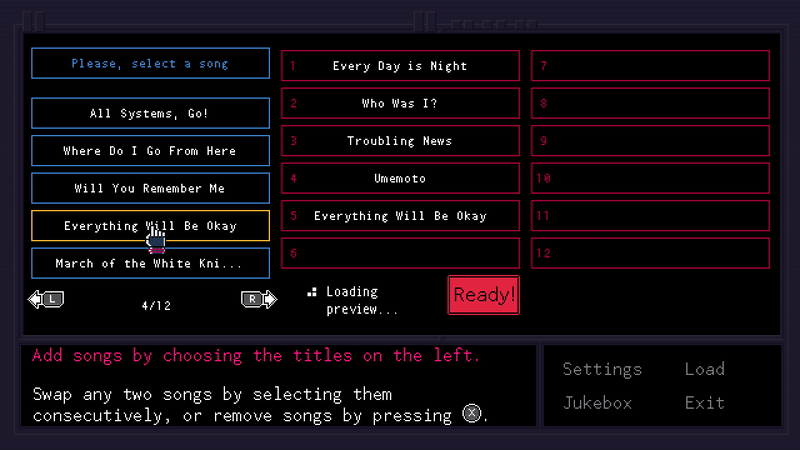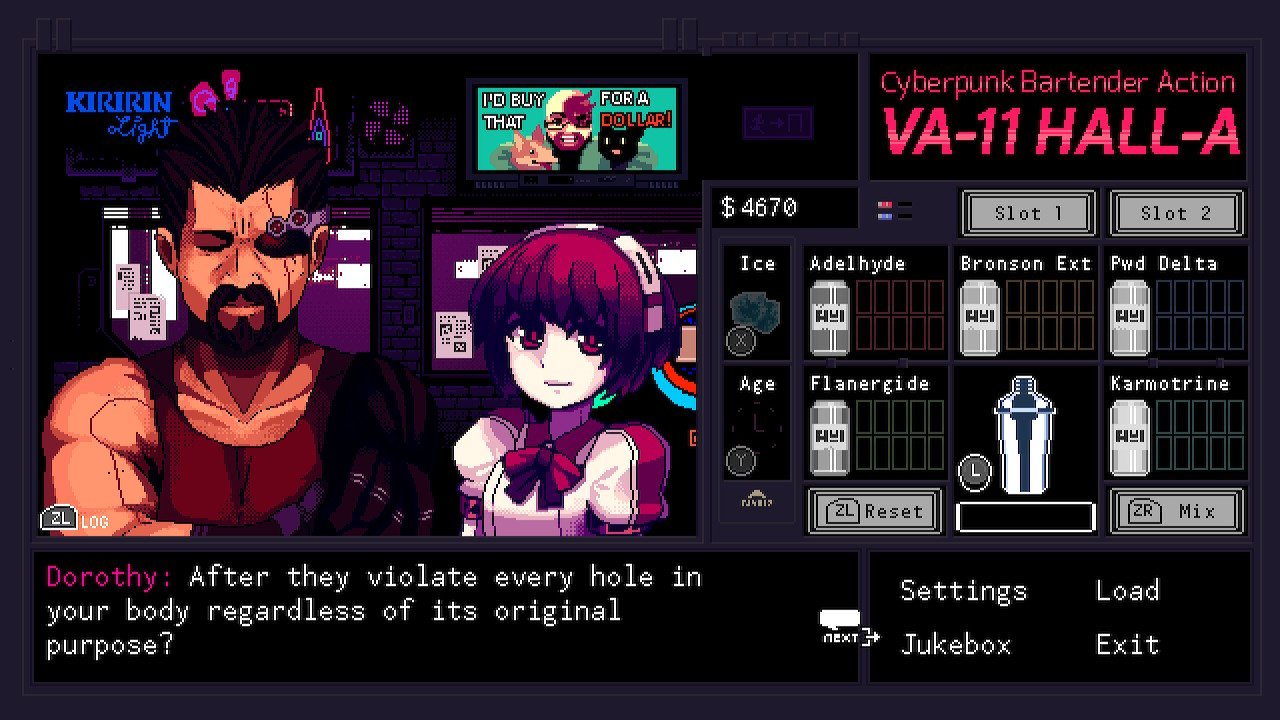VA-11 Hall-A: Cyberpunk Bartender Action - In Review
There comes a time in everyone’s journey when they need to take a step back for a moment. For whatever reason things just aren’t coming together and they let their mind drift. Quite often in film (or in my case on Netflix), this is where they enter a local bar and have a one-to-one with whoever happens to be serving drinks at the time, while they work through their thoughts. I often romanticise the idea of playing the neutral bartender character in series such as Bartender or Midnight Diner, offering sage advice or the perfect drink to help out a client. And at least for the second part of this, a certain game exists by the name of VA-11 Hall-A: Cyberpunk Bartender Action (or Valhalla as per the bar name).
This game takes the formula of bartender & client heart-to-hearts, and switches it up by positioning the bar in a cyberpunk dystopia in the year 207X. By correctly utilising mixology, you are able to change the way the dialogue branches as well as how well you are rewarded. The time setting allows for some interesting conversation on deep philosophical topics and clients don’t hold back (as well as the bartender sometimes), more so than in any other visual novel I’ve played. Get ready for a night to remember as we shake up some conversation (and earn some tips in the process).
The First Night
It all starts off with a basic refresher from a fellow colleague by the name of Gillian (or Gil for short). You play the role of a somewhat dry (sometimes childish humoured) bartender called Jill. She sometimes refers to Gil, as even some clients do, as John, because he has a bit of a ‘John’ face (a running joke that always made me snigger). She seems a little distracted however, as there is a lot going on, including an impending rent payment due else eviction looms. Dana (Jill and Gil’s boss) also makes an appearance with a mysterious unconscious figure draped over her shoulders. Jill is unhappy about this, as if they wake up all hell will break loose. Dana asserted that Jill will just have to deal with it when it happens.
Once the tutorial is complete you then serve your first client; a highly chauvinistic chief editor for an online newspaper. Here you get your first initiation on how cutting the dialogue is by making him a big beer. The first time I made a small one by accident, which prompted him to say something along the lines of: “No I want the beer big, like my dick!”. Turns out you got initiated into the cutting dialogue in the game, which is one of its biggest strengths. If you didn’t make the same mistake as me, you’ll definitely get this from the next client.
One aspect I did find slightly odd during the tutorial was that Gil was testing Jill on making drinks, instead of the more authoritative Dana, even though she was the one that was bar-trained. Directly after the tutorial which he delivered in a somewhat authoritative way, he then becomes the butt of the joke for virtually the rest of the game.
At some point the unconscious customer wakes up, then starts demanding to know where they are. Of course this does not go down well when they are told the bar name: Valhalla. Of course they then start getting panicky, so you are tasked with fixing a good strong drink to calm her down. This introduces you to the intoxication aspect of the game, which is controlled by how you mix drinks. More on that later.
Let’s Set The Mood
During your first night as a (hopefully successful) bartender, you set up a playlist on the jukebox for your shift, and there just so happens to be a rather extensive amount of music available to create the ideal mood. For my personal taste, there was a lot of suitably dreamy synth work as if for a starry night. I also loved the intro song Every Day Is Night. Hearing this every time a shift was started was almost a ritual in itself, along with Jill’s catchphrase: “It’s time to mix drinks and change lives”.
To go with the music, there is also the highly anime-inspired art-style of the game. Each character is beautifully and thematically drawn, with a constrained set of colours in the palette to align the style, almost like an improved version of NES graphics. The neon signage behind the customers was also pretty cool. I liked that you can change the TV channel, which of course I always changed when possible to the famous Robocop reference: “I’d buy that for a dollar!”.
If I had to level a criticism here, although there is considerable joy in the freedom of being able to change your music for the night, I would have liked this to change or be interrupted more frequently to intensify game events or dramatic points of conversation. Perhaps it’s the Ace Attorney player in me but as an example, it makes the music much more dramatic during tense moments, but also more curiosity inducing while probing a witness in the courtroom. I felt it added more gravity and I’d like to have seen more change here, if only to add a more diverse set of moods to the story. This is particularly relevant with the White Knights, a group of self-proclaimed protectors from a questionable corporation called Zaibatsu. Events did happen, and there was music in the jukebox relating to them that was never heard, which could have been used to accentuate the story.
Chemical Mixology
Let’s dive into the main part of the game that you have control over; mixing drinks. At certain times during conversation you will be asked to mix up a drink for a client. Sometimes these are very straightforward and you can just find these by name in your Drinktionary, or through other categories such as flavour, type & bottled drinks. At times the request might be more ambiguous or obtuse. They may ask for something sweet or maybe girly, or there may be a rare time when you require a special bottled drink for the job. Sometimes, the client will request the ‘usual’, which can cause a small state of panic on occasion as you attempt to cast your mind back. The one client that stood out to me however was a chap called Virgilio. The question mark on his head says it all and you will find your frustration with his requests piqued.
The first aspect about the mixing system is that there are only 5 ingredients here each with unusual chemical-based names, although the one you will likely remember most is Karmotrine (which measures alcohol strength). You also have different methods which involve ageing or serving on the rocks as well as mixing or blending drinks, which mean different shaking times are required. If this is played on a Nintendo Switch, there is also haptic feedback to indicate timing. If a mistake is made the drink will turn into a complete mess, which simply means chucking it out and trying again.
However, while it is relatively fun to mix drinks, I do have a couple of issues with this system. Although the game is by-and-large pushed as a relaxing game, formed of around 80%-90% dialogue and story (very much expected being a visual novel), I can’t help but feel that there needed to be some penalisation for time and/or mixing drinks wrong in the moments you are required to be the bartender. Something like less tips if you took too long or less wages for wasting ingredients. Or perhaps even a special ‘Professional’ bonus for not even looking at the Drinktionary to make the drink. Correctly doing this would give some satisfaction to the player when they nailed the order.
As an example from another visual novel game, the Ace Attorney franchise (where you play the part of a defence lawyer) breaks up dialogue using a cross-examination mechanic. Here you point out inconsistencies in witness testimony based on what you’ve heard and the evidence that’s been presented. Failure to do this would result in one of 5 chances to be struck off, the eventual result being game over with a verdict of guilty. This encourages you to dig deep during trial, as you want to nail it as a professional lawyer just like you would want to nail mixing the drink as a professional bartender in order to avoid penalties and master your craft.
One final small gripe is that you can’t tell how well you’ve done until the end of the night (made up of two sections with several clients in each). I would have liked a little feedback during and just after mixing, so I could identify mistakes more frequently to learn and improve. At present, the only info displayed is the company earnings, which doesn’t help understand current individual earnings for Jill.
Now For Some Me Time
Once the night is over, you now know how much money has been made and Jill heads back to the flat to chill out. Here you can do a few things such as scroll on your phone, head to the shop or later on change up your flat using Nanocamo (again on your phone but worth a separate mention).
On the phone, you can catch up on the latest articles from various sources in a familiar way. For the latest journalistic news there is the Augmented Eye. There is also the Danger/u/ thread which reads similarly to how a discussion does on Reddit. Here the users seem to take all angles and sometimes come up with bizarre things that don’t even fit the thread - pretty realistic then. These are well-executed as they help to really build out the lore and current events, adding more flavour. I also found the bias towards the surge in waifu video game popularity to be particularly entertaining. I also loved it when Jill had amusing conversations with herself also playing the role of her cat, Fore, in relation to whatever article was being read at the time.
Later on, you can purchase customisations for the flat using an app called Nanocamo. There is also a shop where you can buy items for the flat, as well as a few secret items that can be unlocked in the bar. You can see a nice little animation to the right picturing Jill in her flat as the customisations get added. A word of warning here however, money is tight in this game and there is significant financial overhead. Occasionally, on returning to the flat Jill will require the purchase of an item, otherwise she will be distracted the following day. More on that later on.
People & Stories
Throughout the entire game, a large variety of clientele will grace the bar. They arrive with differing perspectives and problems, which come together to form the big picture of life in this dystopia. An interesting aspect is that they are largely on the human to machine scale, with some having a higher percentage of robotic prosthesis than others. Lilim on the other hand have been created to be fully mechanical, but have gradually evolved in their computations to start to beg the question of whether they can be regarded as human or not. Sometimes clients even transcend different species. There’s also a particular client that holds a Seinfeld easter egg, which I thoroughly enjoyed. If you’re a fan, you’ll know it when you see it!
As mentioned before, the dialogue does not hold back. There are a number of highly mature and sometimes taboo subjects such as prostitution, underage fetish and physical objectification. An example of this is how Jill objectified one of her female friends called Alma, a cybersecurity consultant who she incidentally also fancied. Jill often cracked jokes about the size of her breasts, which later on prompted other characters who couldn’t remember her name to simply refer to her as ‘titty hacker’. Sometimes moments like these can make you spit out your drink. I certainly found the cutting dialogue to be one of this game’s strengths. Also extra points for the ever-cheerful lilim (what we know as an android) called Dorothy who is always a joy to engage with, although it probably won’t be for the reasons you expect!
Of course, as this is also a game about mixology, how you mix drinks can occasionally change outcomes in the dialogue. Adding more karmotrine to a drink may cause a client to spill the beans. Or serving the perfect drink can cause them to open up to you more. This can even unlock more endings down the line (yes this is a game with multiple endings). If during the night time chillout you failed to buy the current item to stop Jill being distracted, you will need to pay even closer attention to what the client says, as you will not be able to refer back when the Drinktionary is on-screen. You usually get a final hint on-screen but this will be unavailable if distracted.
The ideas in this game are pretty good then, with a lot to enjoy. However, I do feel that there is not enough gravity or sway in the dialogue depending on how you mix the drinks. Although you can get a few extra lines of conversation from mixing more Karmotrine into a drink, this happens only very occasionally and has little (if any) lasting impact on how the story plays out. So although dialogue does branch a bit, it’s only temporary most of the time. I feel more could have been extracted from the idea of intoxication, where different drink types or flavours hold different behavioural qualities. This way, you would try to engage with the character more to influence their mood, adding more depth and understanding.
This brings me to my final gripe about the game, which surprisingly is that for the most part, I didn’t feel as invested in the characters as much as I wanted to be. And there is a wide range of characters. For this, I’ll need to compare it to an old title, Hotel Dusk: Room 215 (a hand-drawn visual novel with film-noir style investigative mechanics and dialogue originally created for Nintendo DS). It’s a tale about an ex-cop, now a door-to-door seller, who spends a night at a hotel. Over the course of the night, he gets to know the guests through subtle questioning (old habits I guess).
A variety of people are encountered similarly to VA-11 Hall-A, from a brattish child to a headstrong owner to a mysterious silent female figure. Once enough info was gathered, the squeeze was really put on them later to get their full story. The atmosphere intensified and with successful probing they would eventually buckle under the pressure. There was also increased weighting on your decisions here, as choosing the wrong option would result in a game over. Whether it was the art, writing, the increased intensity during a squeeze or the way the dialogue gradually pieced together their story through questioning, you really found yourself understanding and empathising with the characters. You sometimes wished that you didn’t have to push them so hard, but needed to do so to find out the truth about the hotel, which as it turns out is more connected than it seems. You really get to know and feel for the characters and I would have liked to have felt a similar affinity to the characters here. Sometimes it’s more like you just have to take their word for whatever they say, instead of really feeling it.
Summary
This is a game with some great ideas; being the go-to bartender and mixing drinks is satisfying as well as the people and stories. Glitch City is built up well through interactions with both conversations with clients and news feeds. There are genuine moments of shock and laughter with some of the cutting dialogue that are highly enjoyable, and the clients are memorable & well-drawn. The variety of music available is broad and some of the more introspective moments in the dialogue are great to be part of. However, I do feel said ideas could have been squeezed a bit more. Penalising the player for incorrectly mixing drinks would give opportunities for them to learn and master their craft, and lead them to better understand and grow a bond with clients. This with more nuanced intoxication control could have influenced dialogue in more fluid and meaningful ways. Lastly more interruption events and curve-balls in both dialogue & music would test the player, introduce some peril, and give opportunities to really seal that bond with clients.
All this being said, the best thing to do is give this one a go. It’s an experience worth taking if not for the moments that can catch you off guard and allow you to play that role of bartender for a while!













